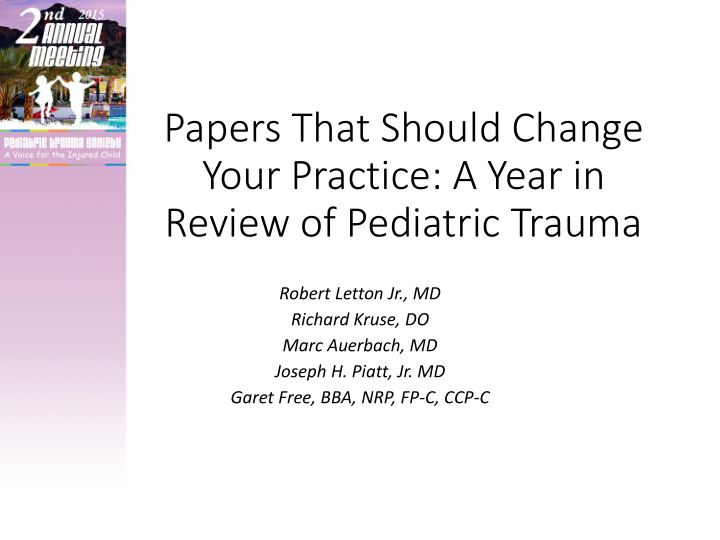



Papers That Should Change Your Practice: A Year in Review of Pediatric Trauma Robert Letton Jr., MD Richard Kruse, DO Marc Auerbach, MD Joseph H. Piatt, Jr. MD Garet Free, BBA, NRP, FP-C, CCP-C
Treatment trends in adolescent clavicle fractures Increase in surgical treatment Lack of high-level studies comparing outcomes of operative and conservative to justify this recent trend Is there a deficit after nonoperative versus operative treatment of shortened midshaft clavicular fractures in adolescents? Shortened midshaft clavicular fractures had excellent outcomes after both operative and non-operative treatments No subjective or objective differences were observed between treatment groups Sports participation and radiographic findings of adolescents treated nonoperatively for displaced clavicle fractures Fracture shortening and sports participation do not have a significant impact on outcomes in adolescents after displaced midshaft clavicle fracture
Th The e Prevale lence of of Brui ruising Amon ong In Infants ts in n Ped edia iatr tric ic Em Emer ergency Dep epartm tments Mary C. Pierce, MD*; Julia N. Magana, MD; Kim Kaczor, MS; Douglas J. Lorenz, PhD; Gabriel Meyers, MSW; Berkeley L. Bennett, MD, MS; John T. Kanegaye, M. Ann Annals s of of Em Emergency Medicine, July 2015 • Bruising is the most common initial injury noted in physical abuse • Prevalence of bruising unknown in infants presenting to PEDs • Patients: 2488 infants < 12 months presenting to 3 PEDs • Excluded referrals for abuse, coagulation abnormality, skin dx, nueromuscular dx • Intervention: Complete skin exam for bruising • Outcome: Prevalence of bruising +/- abuse evaluation • 3.5% – 88/2488 (1.3% medical complaint) • < 6 months: 1.3% prevalence (50% abuse evaluation) (0.2% medical complaint) • Abuse evaluations: 23% < 12 months, 50% < 6 months • Clinical implications • ALL infants in gowns may improve detection of bruising and physical child abuse • Many infants with bruising do not have abuse evaluations • Don’t cruise, Don’t bruise • No bruise ≠ No trauma Bruise ≠ No trauma
• Pediatrics 135:e851-857, 2015 • 350 infants or toddlers who had CT scans with(out) skull rads. Exclusions. 201 admitted; 149 discharged from ED. 62 repeat scans. Zero neurosurgical interventions [95% CI 0 to 0.009]. • Young children with ILSFx and normal neuro exam and mental status do not need to be admitted. • Or transferred to a Level 1 center!!!
Prehospital Pain in Management in in Children Wit ith Traumatic In Injuries Anna Rutkowska, PhD and Grazyna Skotnicka-Klonowicz, MD, PhD Ped ediatr Em Emer Car are 20 2015 15; ; 31 31: : 31 317-320 20 • Key points: Of 489 children requiring emergency analgesia, only 159 received analgesics. • Conclusion: Analgesia in the pre-hospital setting is inadequate for pediatric trauma patients. • Why important to your practice: Additional research is needed, but collaboration between EMS, peds EM and peds trauma surgery is needed for protocol optimization and to provide better care.
J Trauma Acute Care Surg. 2015;79: 683- 693. • A GRADE based analysis to assess the evidence supporting a physiologic based guideline for the management of pediatric solid organ injury • The original APSA guideline for pediatric blunt solid organ injury was instrumental in improving care, but sufficient evidence now exists for an updated physiologic based management guideline • There is a high degree of variability in the management of SOI in pediatric and adult trauma centers. While no algorithm can replace clinical judgment this alorithm defines failure end-points and shortens the stay and resource utilization for patients with no signs of bleeding
Recommend
More recommend